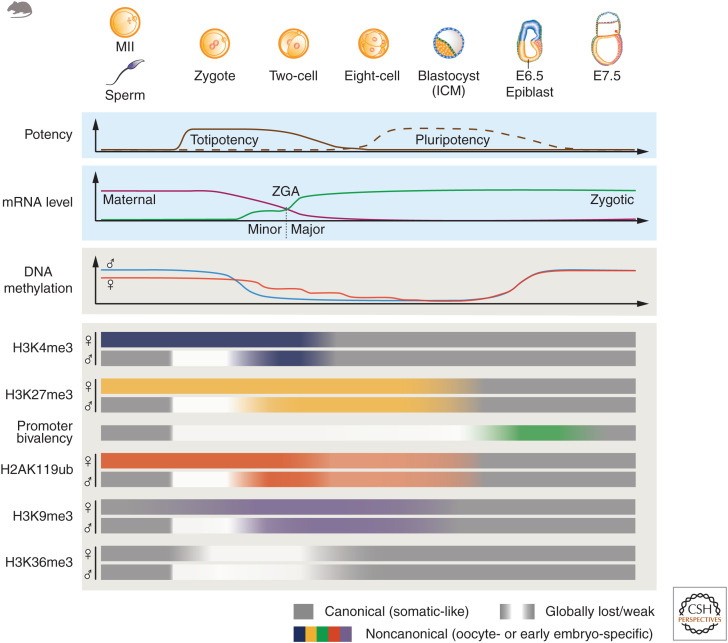Figure 1.
Transcription and epigenetic dynamics from gametes to embryos in mouse. After fertilization, the terminally differentiated gametes are converted into a totipotent zygote. Inner cell mass (ICM) cells from blastocysts are pluripotent and can give rise to all embryonic tissues. The accumulated maternal mRNAs undergo degradation after fertilization, while minor and major zygotic genome activation (ZGA) emerge around the one-cell and two-cell stages, respectively. Parental genomes undergo global DNA demethylation starting from the zygote stage and the reestablishment of embryonic DNA methylome occurs in postimplantation embryos. For histone modifications, sperm largely display canonical distributions (similar to somatic cells), while oocytes and early embryos often acquire noncanonical patterns. H3K4me3 and H3K27me3 form noncanonical broad domains in oocytes, which are transiently inherited to the maternal allele of embryos (except for promoter H3K27me3). The sperm H3K4me3 and H3K27me3 quickly attenuate after fertilization. Weak and extremely large domains of H3K4me3 (at gene-rich regions) and H3K27me3 (at gene deserts) are de novo established on the paternal genome in zygotes. Concomitant with ZGA, both maternal and paternal H3K4me3 are reprogrammed to the canonical patterns, while the distal H3K27me3 domains persist until blastocyst, before being transformed into a canonical state in postimplantation embryos. Bivalency at developmental genes exists in mature gametes but is missing in preimplantation embryos. In E6.5 epiblast, H3K27me3 and unusually strong H3K4me3 form “super bivalency” (green), which is subsequently attenuated at E7.5. In mouse sperm, H2AK119ub resides at the promoters of canonical Polycomb targets. In mouse oocytes, it forms broad distal domains in H3K27me3 marked PMDs, and also occurs at active promoters associated with H3K4me3. Upon fertilization, H2AK119ub undergoes drastic changes, with global resetting of sperm signals but brief inheritance of oocyte H2AK119ub in one-cell embryos. H2AK119ub then rapidly remodels (mainly from the paternal allele but also partially from the maternal allele) and adopts similar patterns between the two alleles from the two-cell stage. After implantation, H2AK119ub and H3K27me3 become colocalized again at developmental gene promoters. H3K9me3 marks both a subset of promoters and LTRs in gametes. After fertilization, H3K9me3 is globally reset in an allele-specific manner, and the asymmetrical distribution of H3K9me3 persists to blastocyst. H3K36me3 enriches at actively expressed gene bodies in gametes. After fertilization, H3K36me3 is globally removed and is then reestablished upon ZGA. The enrichment of epigenetic modification is indicated by the widths and shades of the bars.

